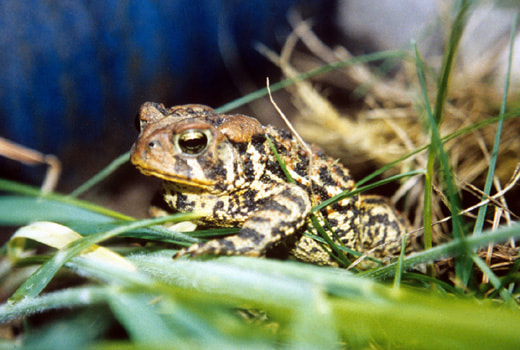|
I LOVE Toads. I have always loved toads. My first memory of a toad encounter was as a toddler, I of course reached over to pick up this unique never before seen creature and it promptly peed on me. I giggled. My mother explained, as she gently put the toad back on the ground, when toads are scared they pee on the intruder as a mechanism to ward off the enemy. Keep in mind I was around 4 years old and I kept thinking about that all day – “How Cool IS that – PEE on someone that scares you!” Now, I knew enough even at that young age, that I should NOT DO that! BUT, the concept kept me delighted ALL day and for several days afterward. I still love toads and this is an ode to, Mr. Toadie, a large Grandpa Toad. A large American Toad (Anaxyrus americanus) arrived every evening outside of my front door usually around 7:30 pm. I am certain he was initially attracted to the increase of insect activity from the outside light, but he would not hop away when I came out. That first encounter I was impressed by his size and beauty. He had gorgeous markings. I approached slowly and could not help myself, I reached out and gently stroked his back. Instead of hopping away, he closed his eyes slightly and leaned into my touch. I stroked him a few more times and then I went back inside. Each evening around the same time, I would go and look for him. Usually, I would not need to search for long as, he would promptly show himself. I would offer him a few gentle strokes down his back, keep my dogs away from him and return inside. He was an impressive specimen, much larger than the standard 2 – 3.5” – he was closer to 5”. Given that the American Toad on average lives 5 – 10 years, my guess he was closer to the decade marker and possibly he was even older. He was large when I first met him and the following three years, he grew a little more each year.
A side note, it is important to keep your curious pets away from toads. They secrete bufotoxin from glands behind their eyes. Although the toxin secreted by the American Toad is not going to kill your pet, they will create foaming at the mouth, potential swelling and sores inside their mouth. There are toads, the Cane Toad and the Colorado River Toad, who do secrete enough of the toxin to kill a curious pet. Thankfully, neither of these toads live anywhere near Wisconsin. I noticed within a week, Grandpa Toad would appear like clock-work, and he seemed to watch for me. He always allowed me to approach and I would gently stroke his back. Each time, he would partially close his eyes and lean in. I knew he enjoyed the gentle touch and I suspect explained why he would be hanging around the front door each evening, since our property was an insect smorgasbord…he could have found plenty of meals anywhere. Last Spring he did not emerge, I suspect he came to the end of his lengthy life span or maybe due to his increasingly large size, he was unable to dig himself deep enough into the ground to survive the bitter cold winter. Toads can survive extremely cold temperatures as they have high levels of glucose in their blood streams which helps keep them from forming ice crystals which would puncture their vessels and vital organs. Each spring the toads emerge to find a mate and lay their eggs in a long strand in still water. In Northern Wisconsin this annual affair begins in late April or Early May depending of course on the weather. Each year I listen for their distinctive song which you can listen to on the Wisconsin DNR website: . When the tadpoles emerge, they form schools. You probably already have some toads in your garden, but if you are not certain, offer them a little shelter such as a clay pot that has an “opening” on its top edge. Turn it upside down and you will have a toad house. Or, lay a clay pot on its side under your foliage (bushes or hosta’s work well). Last spring, there was a smaller toad that arrived each evening around the same time. He has distinctly different markings than Grandpa Toad, but I like to think he is one of his grandsons. Happy Toad Singing and Frog Trilling Season to You All. Visit the WI Department of Natural Resources Website for more information on the American Toad.
0 Comments
Leave a Reply. |
|
| North Country MGV | gARDEN bLOGS |
Location |
|

 RSS Feed
RSS Feed